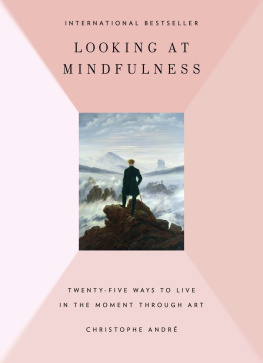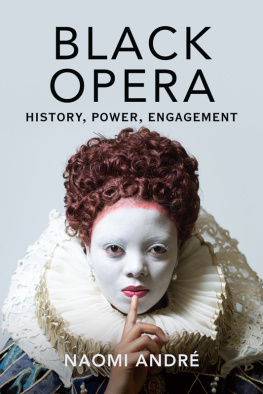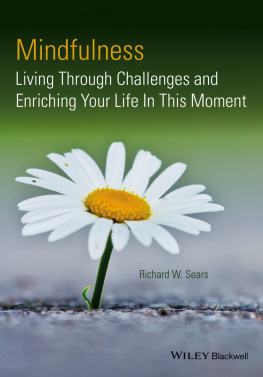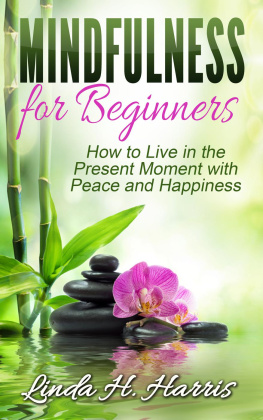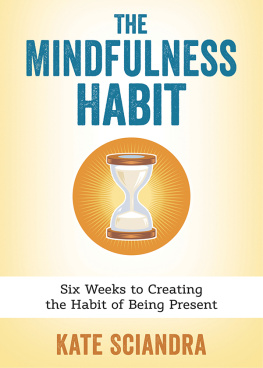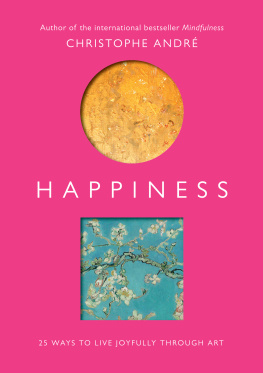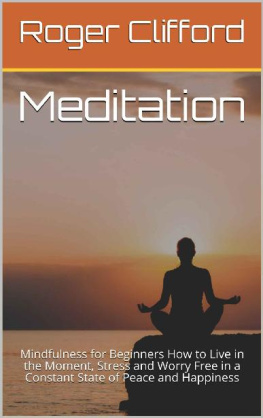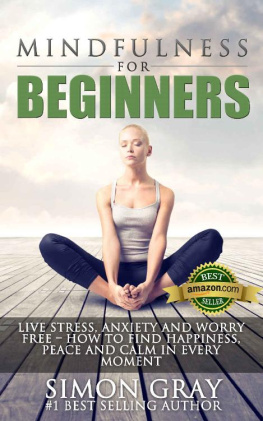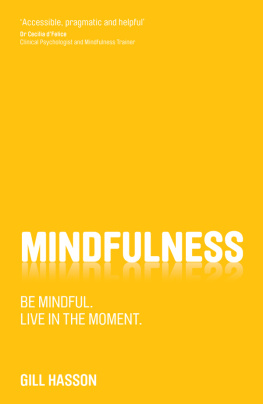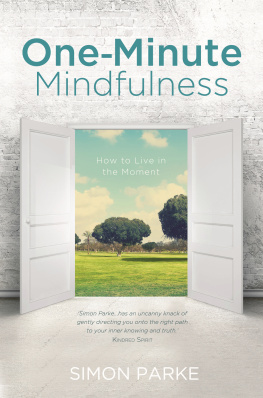André - Looking at mindfulness: 25 ways to live in the moment through art
Here you can read online André - Looking at mindfulness: 25 ways to live in the moment through art full text of the book (entire story) in english for free. Download pdf and epub, get meaning, cover and reviews about this ebook. City: USA;New York, year: 2014;2015, publisher: Penguin Group;Blue Rider Press, genre: Religion. Description of the work, (preface) as well as reviews are available. Best literature library LitArk.com created for fans of good reading and offers a wide selection of genres:
Romance novel
Science fiction
Adventure
Detective
Science
History
Home and family
Prose
Art
Politics
Computer
Non-fiction
Religion
Business
Children
Humor
Choose a favorite category and find really read worthwhile books. Enjoy immersion in the world of imagination, feel the emotions of the characters or learn something new for yourself, make an fascinating discovery.
- Book:Looking at mindfulness: 25 ways to live in the moment through art
- Author:
- Publisher:Penguin Group;Blue Rider Press
- Genre:
- Year:2014;2015
- City:USA;New York
- Rating:3 / 5
- Favourites:Add to favourites
- Your mark:
- 60
- 1
- 2
- 3
- 4
- 5
Looking at mindfulness: 25 ways to live in the moment through art: summary, description and annotation
We offer to read an annotation, description, summary or preface (depends on what the author of the book "Looking at mindfulness: 25 ways to live in the moment through art" wrote himself). If you haven't found the necessary information about the book — write in the comments, we will try to find it.
André: author's other books
Who wrote Looking at mindfulness: 25 ways to live in the moment through art? Find out the surname, the name of the author of the book and a list of all author's works by series.
Looking at mindfulness: 25 ways to live in the moment through art — read online for free the complete book (whole text) full work
Below is the text of the book, divided by pages. System saving the place of the last page read, allows you to conveniently read the book "Looking at mindfulness: 25 ways to live in the moment through art" online for free, without having to search again every time where you left off. Put a bookmark, and you can go to the page where you finished reading at any time.
Font size:
Interval:
Bookmark:

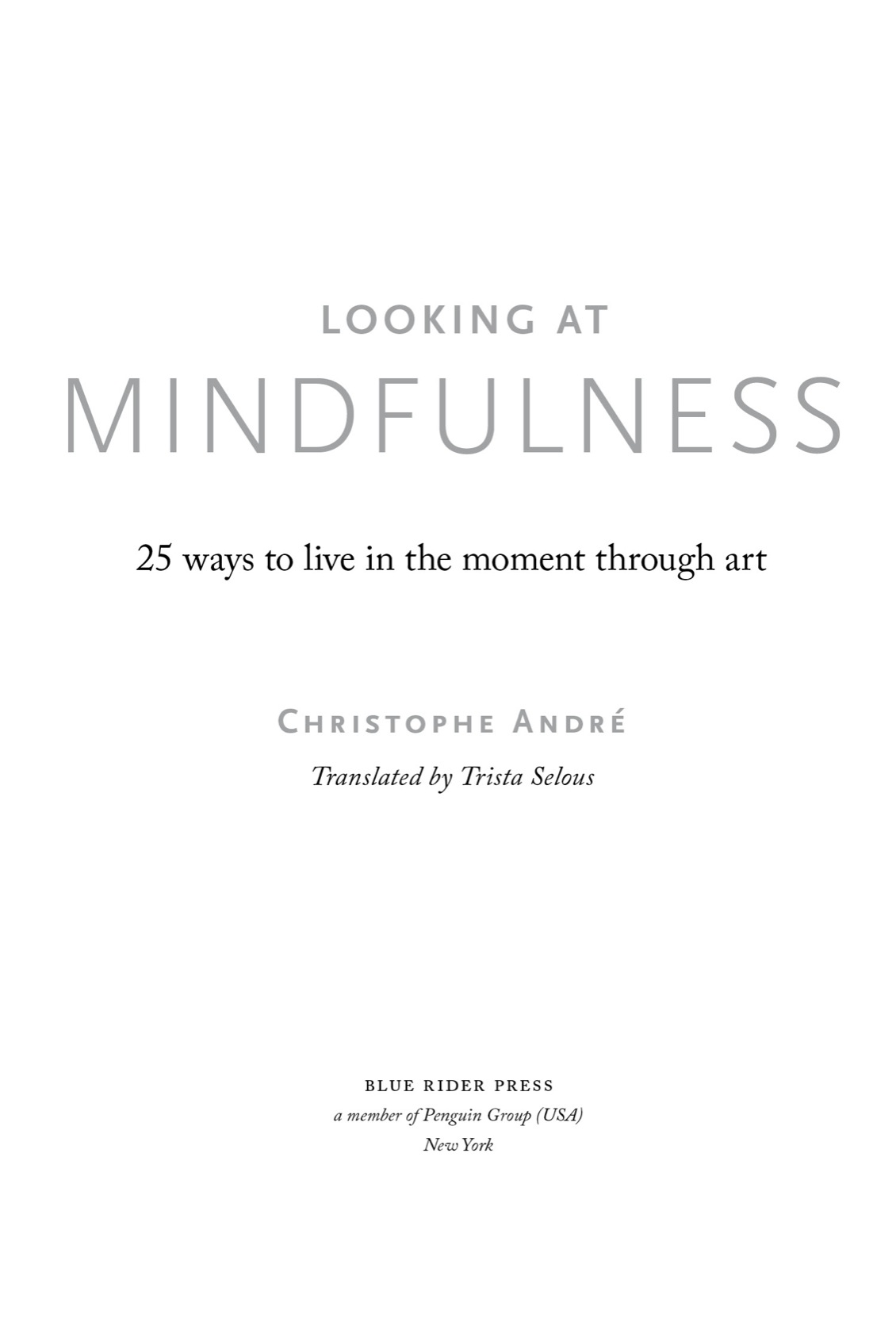

Published by the Penguin Group
Penguin Group (USA) LLC
375 Hudson Street
New York, New York 10014

USA Canada UK Ireland Australia New Zealand India South Africa China
penguin.com
A Penguin Random House Company
Copyright 2011 by LIconoclaste
Translation copyright Rider Books 2014
Penguin supports copyright. Copyright fuels creativity, encourages diverse voices, promotes free speech, and creates a vibrant culture. Thank you for buying an authorized edition of this book and for complying with copyright laws by not reproducing, scanning, or distributing any part of it in any form without permission. You are supporting writers and allowing Penguin to continue to publish books for every reader.
Originally published in France as Mditer, Jour Aprs Jour by LIconoclaste, Paris, in 2011
The English edition was first published in Great Britain as Mindfulness in 2014 by Rider, an imprint of Ebury Publishing. Ebury Publishing is a Random House Group company.
Christophe Andr has asserted his right to be identified as the author of this work in accordance with the Copyright, Designs and Patents Act 1988.
Blue Rider Press is a registered trademark and its colophon is a trademark of Penguin Group (USA) LLC
ISBN 978-0-698-40161-7
Version_1
With grateful thanks
To Jon Kabat-Zinn for his vision,
To Zindel Segal for his knowledge,
To Matthieu Ricard for his example,
And to all three for
their teaching and friendship.
By the same author
Feelings and Moods
The miracle is to walk on Earth.
Thich Nhat Hanh
L iving in mindfulness means paying regular, calm attention to the present moment. This attitude can radically alter our relationship to the world, ease our suffering and enhance our joys. Mindfulness is also a type of meditation. Its basic techniques are quick and simple to learn, but take years to master fully (like everything in life that matters to us).
To move toward mindfulness we must first understand what it is and how it is practiced. The words in this book offer insight into these things. We must then free ourselves from words in order simply to sense and feel, and the paintings will help with this. Lastly we must practice and experiment on our own. Advice and exercises are suggested throughout the pages that follow. The secrets of living in mindfulness can be summed up in three words: understand, feel and practice, over and over.
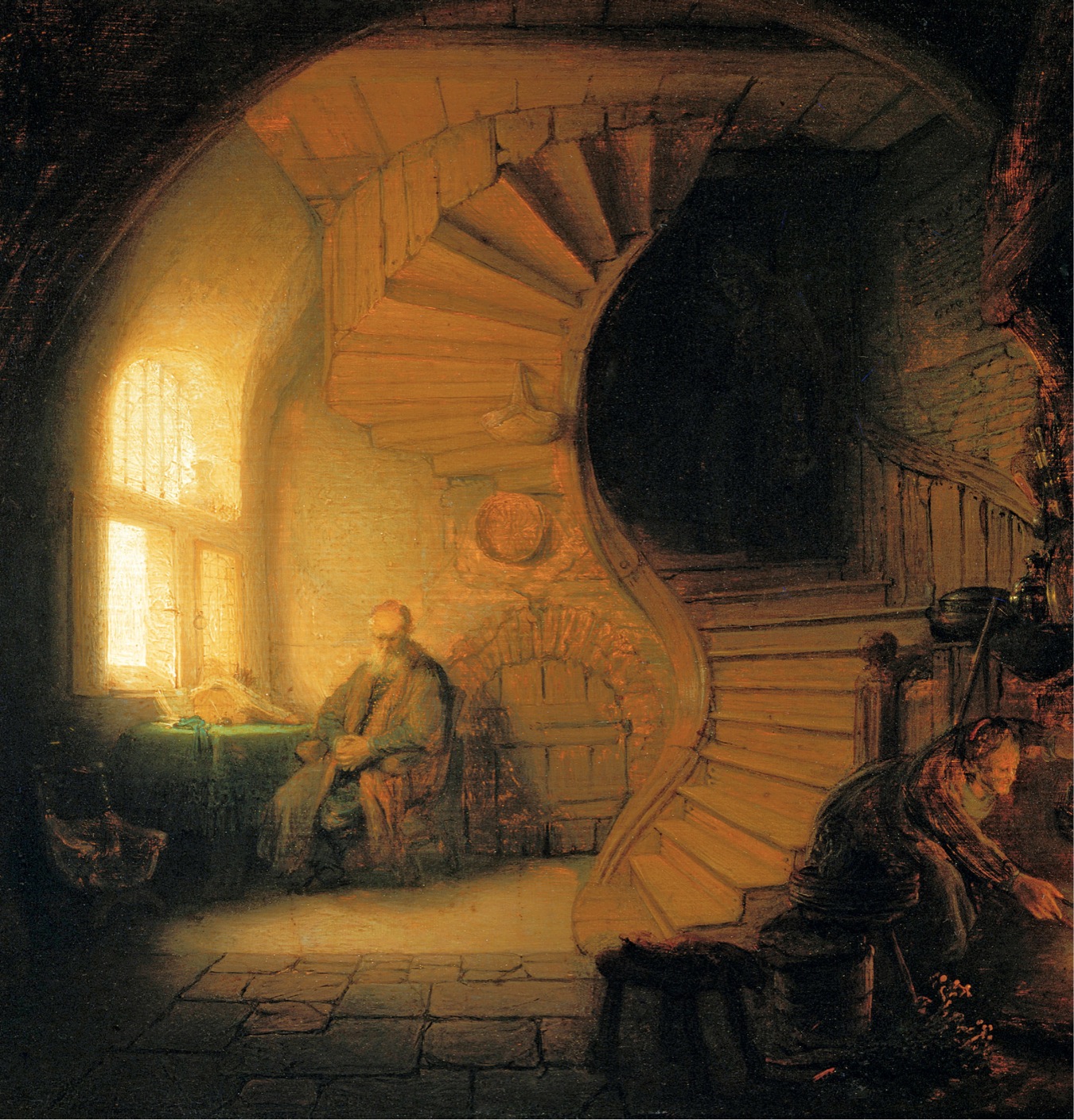
PRESENCE,
NOT EMPTINESS
Divinely I meditate
And I smile at all the beings
I have not created.
Guillaume Apollinaire, Alcools (trans. D. M. Black)
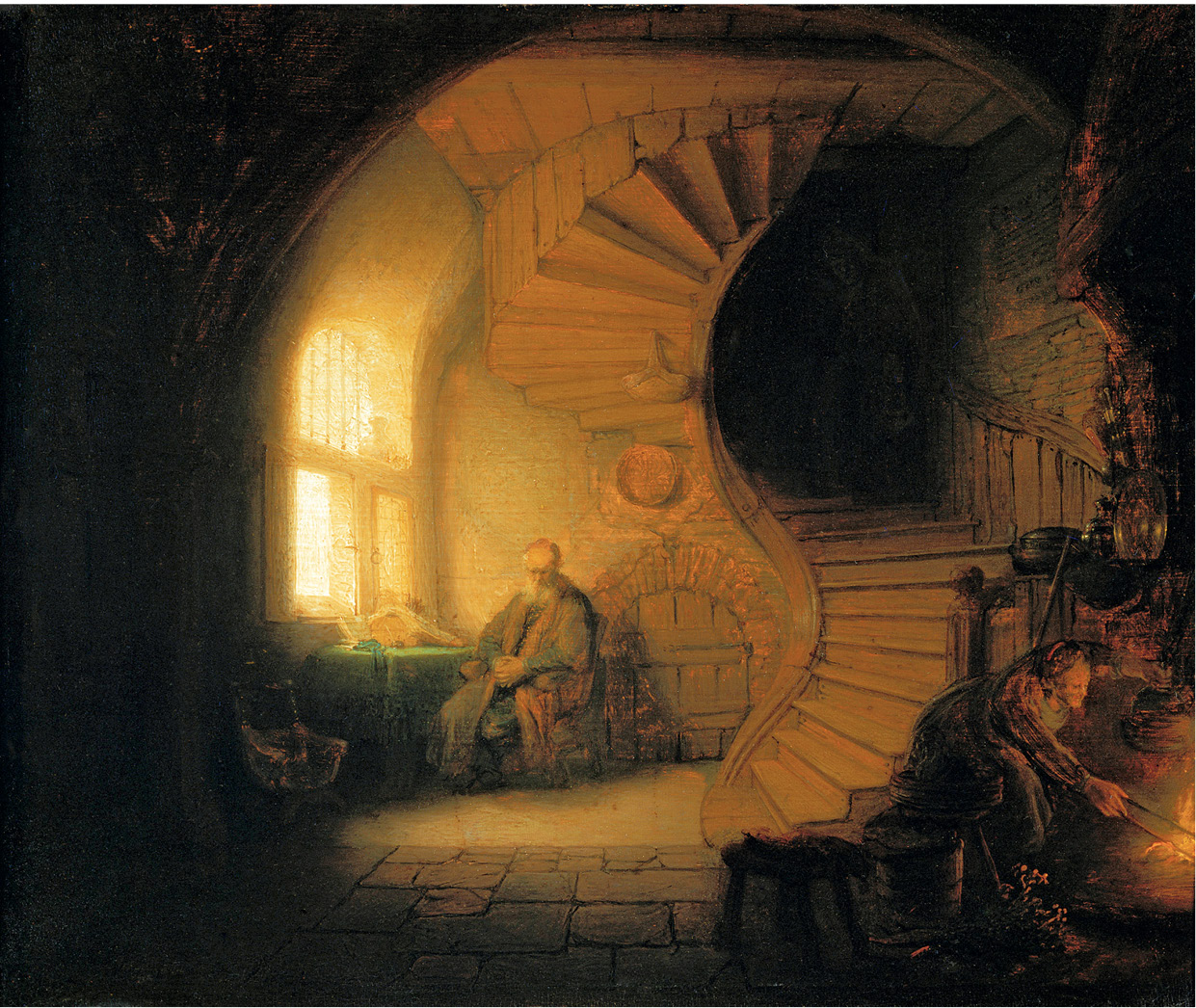
Philosopher in Meditation, Harmensz Van Rijn, known as Rembrandt (16061669)
1632, oil on wood, 28 x 34 cm, Muse du Louvre, Paris
T he first thing we see is the intense, yellow light of the winter sun outsidea sun that dazzles without warmth. Then we notice the old man sitting motionless, having turned away from his table and the book he was studying. Is he thinking? Resting? Meditating? We look to the right and notice the low cellar door, then our eyes are drawn to the spiral staircase, but we have barely registered its first few steps when we notice the fire crackling in the grate and the woman stoking it. Our eyes return to the staircase, but it leads only into darkness.
The painting is small, the place it depicts is dark, yet we have a sense of immense space. This is the genius of Rembrandt, who leads us on a visual journey through all the dimensions. We travel the painting widthways left to right, from the daylight pouring in to the fragile, almost derisory firelight. Theres a dialogue established between the sun that lights but does not warm and the fire that warms but sheds no light. Are these the sun of reason and the fire of passion, two ingredients that combine in philosophy? We travel the paintings height by means of the spiral staircase that links the deep secrets of the cellar to the dark mysteries of the upper floor, and we travel its depth, from the background where the philosopher sits to the surrounding circle of shadows. But the sense of space also derives from the subtle interplay between all that is revealed and all that is hidden, where our imagination is crucialwhat lies on the other side of the window, behind the cellar door, at the top of the stairs? The largest of the worlds hidden from our restless eyes is the philosophers mind, his inner world. Shadows and darkness, a little light, a little warmth and a working mindis that what our inner selves are like?
Meditation means stopping
Stop doing, stop moving, stop twisting and turning. Meditation means withdrawing a little, stepping back from the world.
At first what we feel seems odd. Theres an emptiness (no action or distraction) and a fullness (a tumult of thoughts and sensations that we suddenly notice). Theres what we lackpoints of reference and things to doand, after a little while, theres the calm this lack brings. Things here are not the same as they are outside, where our mind constantly attaches itself to some aim or project, acting or thinking about something in particular, having its attention held by some distraction.
The apparent inaction of the experience of meditating takes a little while to get used to. As in Rembrandts painting, or when we move from light to shadow, we dont see clearly straightaway. We have gone inside ourselves, for real. Our inner world was close by, but we never went there. We tended to hang around outside; in todays world of frantic demands and frenzied connections, our relationship to ourselves often goes untended. We abandon our inner world. The outside world is easier to travel and better signposted. To meditate is often to move through a land without paths. In the room where the philosopher is meditating theres less light, so you have to open your eyes wider. The same is true inside ourselves. There is less that is obvious or reassuring, so we must open our minds eye much wider.
We expectedor hopedto find calm and emptiness. We often find ourselves in a huge, rowdy, chaotic bazaar. We aspired to clarity, we find confusion. Sometimes meditation exposes us to anxiety and pain, to things that hurt us and that we have avoided by thinking about something else or busily doing things elsewhere.
Calming agitation
It all looked so simple from the outside! We thought it would be enough just to sit down and close our eyes. But no, thats just the start. Its indispensable, but not enough in itself. So what now? Now we have to work. We must learn to look, to remain slightly apart from the world, sitting just like this with closed eyes. We must learn to allow the tumult to settle.
Font size:
Interval:
Bookmark:
Similar books «Looking at mindfulness: 25 ways to live in the moment through art»
Look at similar books to Looking at mindfulness: 25 ways to live in the moment through art. We have selected literature similar in name and meaning in the hope of providing readers with more options to find new, interesting, not yet read works.
Discussion, reviews of the book Looking at mindfulness: 25 ways to live in the moment through art and just readers' own opinions. Leave your comments, write what you think about the work, its meaning or the main characters. Specify what exactly you liked and what you didn't like, and why you think so.

